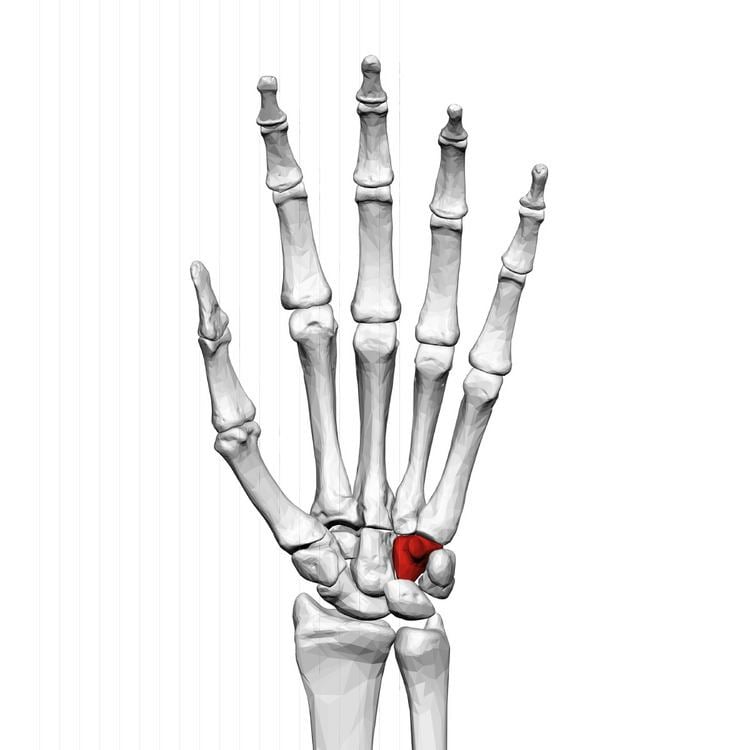Latin Os hamatum TA A02.4.08.012 | Dorlands/Elsevier o_07/12598356 FMA 23730 | |
 | ||
Articulations Articulates with five bones:the lunate proximallythe fourth and fifth metacarpals distallythe triangular mediallythe capitate laterally MeSH A02.835.232.087.319.150.400 | ||
The hamate bone (/ˈheɪmət/) or unciform bone (from Latin uncus, "hook") is a bone in the human wrist readily distinguishable by its wedge shape and a hook-like process ("hamulus") projecting from its palmar surface.
Contents
Structure
The hamate is an irregularly shaped carpal bone found within the hand. The hamate is found within the distal row of carpal bones, and abuts the metacarpals of the little finger and ring finger.
Adjacent to the hamate on the ulnar side, and slightly above it, is the pisiform bone. Adjacent on the radial side is the capitate, and proximal is the lunate.
Surfaces
The hamate bone has six surfaces:
Hook
The hook of hamate (Latin: hamulus) is found at the proximal, ulnar side of the hamate bone. The hook is a curved, hook-like process that projects 1–2 cm distally and radially.
The hook forms the ulnar border of the carpal tunnel, and the radial border for Guyon's canal. Numerous structures attach to it, including ligaments from the pisiform, the transverse carpal ligament, and the tendon of Flexor carpi ulnaris.
Its medial surface to the flexor digiti minimi brevis and opponens digiti minimi; its lateral side is grooved for the passage of the flexor tendons into the palm of the hand.
Development
The ossification of the hamate starts between 1 and 12 months. The hamate does not fully ossify until about the 15th year of life.
In animals
The bone is also found in many other mammals, and is homologous with the "fourth distal carpal" of reptiles and amphibians.
Function
The carpal bones function as a unit to provide a bony superstructure for the hand.
Clinical significance
The hamate bone is the bone most commonly fractured when a golfer hits the ground hard with a golf club on the downswing. The fracture is usually a hairline fracture, commonly missed on normal X-rays. Symptoms are pain aggravated by gripping, tenderness over the hamate and symptoms of irritation of the ulnar nerve. This is characterized by numbness and weakness of the pinkie finger with partial involvement of the ring finger as well, the "ulnar 1½ fingers".
The hook of hamate is particularly prone to fracture-related complications such as non-union due to its "tenuous" blood supply.
It is also a common injury in baseball players. Several professional baseball players have had the bone removed during the course of their careers. This condition has been called "Wilson's Wrist".
The calcification of the unciform bone is seen on X-rays during puberty and is sometimes used in orthodontics to determine if an adolescent patient is suitable for orthognathic intervention (i.e. before or at their growth spurt).
Etymology
The etymology derives from the Latin hamatus "hooked," from hamus which means "hook".
